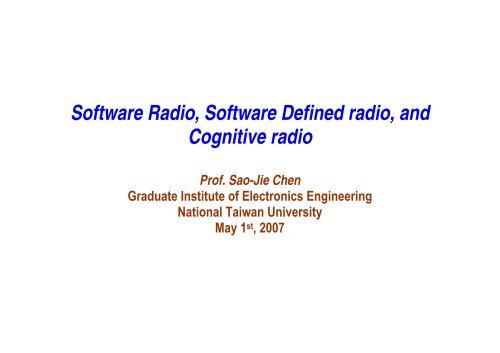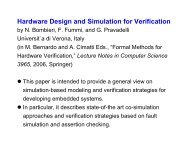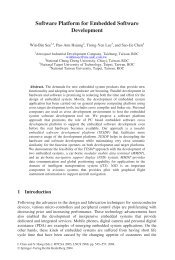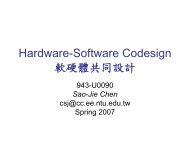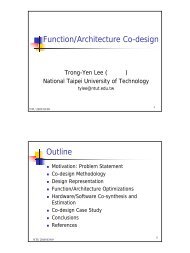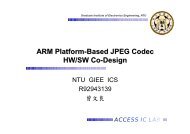Software Radio Software Defined radio and Cognitive radio
Cognitive Radio - the CAD System Lab
Cognitive Radio - the CAD System Lab
Create successful ePaper yourself
Turn your PDF publications into a flip-book with our unique Google optimized e-Paper software.
<strong>Software</strong> <strong>Radio</strong>, <strong>Software</strong> <strong>Defined</strong> <strong>radio</strong>, <strong>and</strong><br />
<strong>Cognitive</strong> <strong>radio</strong><br />
Prof. Sao-Jie Chen<br />
Graduate Institute of Electronics Engineering<br />
National Taiwan University<br />
May 1 st , 2007
What is <strong>Cognitive</strong> <strong>Radio</strong>?<br />
A fully cognitive <strong>radio</strong> should have the ability to do the following:<br />
1. Tune to any available channel in the target b<strong>and</strong>.<br />
2. Establish network communications <strong>and</strong> operate in all or part of the<br />
channel.<br />
3. Implement channel sharing <strong>and</strong> power control protocols which adapt<br />
to spectrum occupied by multiple heterogeneous networks.<br />
4. Implement adaptive transmission b<strong>and</strong>widths, data rates, <strong>and</strong> error<br />
correction schemes to obtain the best throughput possible.<br />
5. Implement adaptive antenna steering to focus transmitter power in the<br />
direction required to optimize received signal strength.<br />
John Notor, “<strong>Radio</strong> Architectures for Unlicensed Reuse of Broadcast TV Channels,”<br />
Communications Design Conference, September, 2003.
Outlines<br />
1. <strong>Software</strong> <strong>Radio</strong>(SR) <strong>and</strong> Softwre <strong>Defined</strong> <strong>radio</strong> (SDR)<br />
2. <strong>Cognitive</strong> <strong>Radio</strong> (CR)<br />
3. CR Architecture<br />
4. CR1 Prototype<br />
5. CR Toolbox<br />
6. CR Case Study
<strong>Software</strong> <strong>Radio</strong> (SR) Architecture<br />
Source<br />
Set<br />
External Environment<br />
Evolution<br />
Support<br />
Channel<br />
Set<br />
Source<br />
Coding<br />
&<br />
Decoding<br />
<strong>Radio</strong> Node<br />
Service<br />
&<br />
Network<br />
Support<br />
INFO-<br />
SEC<br />
Joint Control<br />
Multiple Personalities<br />
Modem<br />
IF<br />
Processing<br />
RF/<br />
Channel<br />
Access<br />
Channel Coding & Decoding<br />
[1] Mitola, J., “<strong>Software</strong> <strong>Radio</strong> Architecture: A Mathematical Perspective,” IEEE Journal on Selected Areas of<br />
Communication, April, 1999.<br />
[2] Mitola, “<strong>Software</strong> <strong>Radio</strong> Architecture Evolution: Foundations, Technology Tradeoffs, <strong>and</strong> Architecture<br />
Implications,” IEICE Tr. Commun. Vol. E83-B, June 2000.
<strong>Software</strong> <strong>Radio</strong> (SR) Architecture<br />
• The Channel Set therefore includes multiple RF b<strong>and</strong>s. Personal<br />
Communications System (PCS) base stations <strong>and</strong> mobile military <strong>radio</strong>s<br />
can also use fiber <strong>and</strong> cable, also included in the channel set.<br />
• Channel coding encompasses programmable RF/ Channel Access, IF<br />
Processing, <strong>and</strong> Modem. Multib<strong>and</strong> antennas <strong>and</strong> RF conversion<br />
comprise the RF/ Channel Access function. RF functions may include<br />
interference suppression.<br />
• IF Processing may include filtering; further frequency translation; joint<br />
space-time equalization; integration of space diversity, polarization or<br />
frequency diversity channels; digital beamforming; <strong>and</strong> smart antennas .<br />
• Bitstream processing includes Forward Error Control (FEC) <strong>and</strong><br />
softdecision decoding.
<strong>Software</strong> <strong>Radio</strong> (SR) Architecture<br />
• Although many applications do not require Information Security<br />
(INFOSEC), there are incentives for its use. For example, authentication<br />
reduces fraud, <strong>and</strong> stream enciphering ensures privacy. INFOSEC may<br />
be null for some applications.<br />
• The source set may include voice, data, facsimile, video <strong>and</strong> multimedia.<br />
Some sources are physically remote from the <strong>radio</strong> node, e.g. connected<br />
via the Synchronous Digital Hierarchy (SDH), a Local Area Network<br />
(LAN), or other network through Service & Network Support.<br />
• Multimode <strong>radio</strong>s generate multiple air interface waveforms (“modes”)<br />
using the modem, the RF channel modulator-demodulator. Waveforms<br />
may be in different b<strong>and</strong>s <strong>and</strong> may span multiple b<strong>and</strong>s. Each<br />
combination of b<strong>and</strong> <strong>and</strong> mode is one of multiple personalities. Each<br />
personality combines RF b<strong>and</strong>, channel set (e.g. control <strong>and</strong> traffic<br />
channels), air interface waveform, protocol, <strong>and</strong> related functions.
<strong>Software</strong> <strong>Radio</strong> (SR) Architecture<br />
• In a software <strong>radio</strong>, all these functions are implemented using digital<br />
techniques in multithreaded multiprocessor software managed by a<br />
Joint Control function. Joint control assures system stability, error<br />
recovery, <strong>and</strong> isochronous streaming of voice <strong>and</strong> video. Joint Control<br />
may evolve towards autonomous selection of b<strong>and</strong>, mode, <strong>and</strong> data<br />
format.
<strong>Software</strong>-<strong>Defined</strong> <strong>Radio</strong> (SDR)<br />
<strong>Software</strong>-<strong>Defined</strong> <strong>Radio</strong> (SDR) Forum, www.sdrforum.org
<strong>Software</strong> <strong>Radio</strong>
Outlines<br />
1. <strong>Software</strong> <strong>Radio</strong>(SR) <strong>and</strong> Softwre <strong>Defined</strong> <strong>radio</strong> (SDR)<br />
2. <strong>Cognitive</strong> <strong>Radio</strong> (CR)<br />
3. CR Architecture<br />
4. CR1 Prototype<br />
5. CR Toolbox<br />
6. CR Case Study
<strong>Cognitive</strong> <strong>Radio</strong> (CR)<br />
[2] J. Mitola III, “<strong>Software</strong> <strong>Radio</strong> Architecture Evolution,” IEICE Transactions on Communications,<br />
July 00.
<strong>Cognitive</strong> Cycle
<strong>Cognitive</strong> Cycle<br />
• <strong>Cognitive</strong> <strong>radio</strong> signifies a <strong>radio</strong> that employs model-based reasoning to<br />
achieve a specified level of competence in <strong>radio</strong>-related domains [5].<br />
<strong>Cognitive</strong> <strong>radio</strong> architectures being investigated at KTH employ the<br />
cognition cycle as illustrated in the above figure [7].<br />
• <strong>Cognitive</strong> <strong>radio</strong> is a goal-driven framework in which the <strong>radio</strong><br />
autonomously observes the <strong>radio</strong> environment, infers context, assesses<br />
alternatives, generates plans, supervises multimedia services, <strong>and</strong><br />
learns from its mistakes [7].<br />
• In the Observe-stage, the cognitive <strong>radio</strong> observes its environment by<br />
parsing incoming information streams, i.e., the outside world stimuli, to<br />
recognize the context of its communications tasks. Incoming <strong>and</strong><br />
outgoing multimedia content is parsed for the contextual cues<br />
necessary to infer the communications context (e.g., urgency). Thus, for<br />
example, the <strong>radio</strong> may infer that it is going for a taxi ride (with some<br />
probability) if the user ordered a taxi by voice <strong>and</strong> is located in a foreign<br />
country.
<strong>Cognitive</strong> Cycle<br />
• The Orient-stage decides on the urgency of the communications in part<br />
from these cues in order to reduce the burden on the user.<br />
• The Plan-stage generates <strong>and</strong> evaluates alternatives, including<br />
expressing plans to peers <strong>and</strong>/or the network to obtain advice.<br />
• The Decide-stage allocates computational <strong>and</strong> <strong>radio</strong> resources to<br />
subordinate (conventional <strong>radio</strong>) software.<br />
• The Act-stage initiates tasks with specified resources for specified<br />
amounts of time.<br />
• Fundamental design rules by which SDR, sensors, perception, <strong>and</strong> AML<br />
are integrated to create Aware, Adaptive, <strong>and</strong> <strong>Cognitive</strong> <strong>Radio</strong>s (AACR’s)<br />
with better Quality of Information (QoI) through capabilities to Observe<br />
(sense, perceive), Orient, Plan, Decide, Act <strong>and</strong> Learn (theOOPDALloop)<br />
in RF <strong>and</strong> user domains, transitioning from merely adaptive to<br />
demonstrably cognitive <strong>radio</strong>, CR.
<strong>Cognitive</strong> Cycle<br />
• Architecture is a comprehensive, consistent set of design rules by<br />
which a specified set of components achieves a specified set of<br />
functions in products <strong>and</strong> services that evolve through multiple design<br />
points over time.<br />
[8] Joseph Mitola III, <strong>Software</strong> <strong>Radio</strong> Architecture, Wiley, 2000].
Outlines<br />
1. <strong>Software</strong> <strong>Radio</strong>(SR) <strong>and</strong> Softwre <strong>Defined</strong> <strong>radio</strong> (SDR)<br />
2. <strong>Cognitive</strong> <strong>Radio</strong> (CR)<br />
3. CR Architecture<br />
4. CR1 Prototype<br />
5. CR Toolbox<br />
6. CR Case Study
CR Architecture
CR Architecture<br />
• Characterized SDR Architecture<br />
• Developed Necessary Mathematical Foundations<br />
– Topological Model of <strong>Radio</strong> Architecture<br />
– Computability Proof for Bounded-Recursive Functions<br />
• <strong>Defined</strong> RKRL (<strong>Radio</strong> Knowledge representation Language) with Set-<br />
Theoretic Axioms<br />
• Invented the Cognition Cycle<br />
• Simulated the Contributions of a Notional <strong>Cognitive</strong> <strong>Radio</strong><br />
– Spectrum Rental, Dem<strong>and</strong> Shaping<br />
• Implemented a Research Prototype CR1<br />
– Simulated environment, not fully integrated, illustrative personalities<br />
• Articulated an Open Architecture Framework
Spectrum Pool Etiquette
Spectrum Pool Etiquette<br />
• <strong>Radio</strong> etiquette is the set of RF b<strong>and</strong>s, air interfaces, protocols, spatial<br />
<strong>and</strong> temporal patterns, <strong>and</strong> high level rules of interaction that moderate<br />
the use of the <strong>radio</strong> spectrum.<br />
• Etiquette for spectrum pooling includes the spectrum renting process,<br />
assured backoff to authorized legacy <strong>radio</strong>s, assured conformance to<br />
precedence criteria, an order-wire network, <strong>and</strong> related topics.
Implications of Spectrum Rental
Integration of Inter-Disciplinary Contributions
Topological Model of Dual-b<strong>and</strong> H<strong>and</strong>set Streams
Topological Analysis<br />
• What are the domain <strong>and</strong> range?<br />
• Are they explicit?<br />
• What are the open sets?<br />
• What are the Unions, Intersections?<br />
• Is each map a homeomorphism?<br />
• Are the inverse images of open sets open?
SR Reference Platform Parameters
RKRL Overview
RKRL Overview<br />
• RKRL as a language has a set of metalevel micro-worlds that define<br />
admissible expressions: inferences, domain knowledge (the knowledge<br />
base), computational, <strong>and</strong> axiomatic models (the formal models).<br />
• RKRL also has a micro-world for each of its multiple knowledge bases,<br />
one for each major sub-domain of terrestrial wireless.<br />
• RKRL describes inferences that can be performed for task-domain<br />
automated reasoning.<br />
• These meso-world components describe <strong>and</strong> control conventional SDR<br />
components (hardware <strong>and</strong> software).
<strong>Cognitive</strong> <strong>Radio</strong> Meso-world Framework
RKRL Defines Knowledge Topology
PDA Architecture Domain
PDA Architecture Domain<br />
• In the above figure, S represents the internal model <strong>and</strong> W represents<br />
the external world, <strong>and</strong> we consider a <strong>radio</strong>’s signal in space, s(t) ∈ W<br />
as illustrated.<br />
• When the PDA receives the signal, it is converted to internal digital form<br />
by an ADC.<br />
• Thus, the signal is mapped first from the transmitted signal to a received<br />
signal, Receive(s), e.g. by the addition of noise <strong>and</strong> multipath.<br />
• Next it is digitized by an ADC to become the discrete signal x(i) ∈ S.<br />
• Thus, the map H from W to S is ADC(Receive(s(t))). Although H<br />
corresponds in part to a physically realizable device, the ADC, H is not a<br />
function that transforms signals. H is a map among subsets of S <strong>and</strong> W.
PDA Architecture Domain<br />
• In words, H states: “The analog signal in the time interval surrounding<br />
the continuous point s(t) ∈ W corresponds to the discrete point x(i) ∈ S<br />
at the sampling instant for N contiguous points.”<br />
• The corresponding map G from S to W is not a digital to analog<br />
converter.<br />
• The map G answers the question “How do subsets of x(i) map to<br />
subsets of s(t)?” This is answered in part by the Nyquist criterion.<br />
• If a signal s(t) is sampled at least as fast as specified by the Nyquist<br />
criterion, then the analog signal s(t) may be reconstructed uniquely from<br />
the digital samples, x(i), e.g. using Fourier series.<br />
• In addition, a received signal corresponds to some transmitted signal<br />
modified by propagation, so G(x(i)) = Propagation(Nyquist(x(i))).<br />
• G also is not a function. One need not be able to perform G on actual<br />
signals. G is the set-theoretic map that specifies which members of S<br />
correspond to which members of W.<br />
• Thus, G <strong>and</strong> H are ontological statements about the structure of the<br />
point sets s(t) <strong>and</strong> x(i).
Heterogeneous Knowledge Representation in RKRL
Heterogeneous Knowledge Representation in RKRL
Behavior as Homeomorphism<br />
• Inferences Map S to S, Actions Map S to W, <strong>and</strong> Sensing Maps W to S
Architecture Mapping
Environment-aware PDA<br />
[9] J. Mitola., “<strong>Cognitive</strong> <strong>Radio</strong> for Mobile Multimedia Communications,” MoMuC, Nov 99.
Outlines<br />
1. <strong>Software</strong> <strong>Radio</strong>(SR) <strong>and</strong> Softwre <strong>Defined</strong> <strong>radio</strong> (SDR)<br />
2. <strong>Cognitive</strong> <strong>Radio</strong> (CR)<br />
3. CR Architecture<br />
4. CR1 Prototype<br />
5. CR Toolbox<br />
6. CR Case Study
<strong>Cognitive</strong> <strong>Radio</strong> 1 (CR 1)
CR1 Rapid Prototype
CR1 Rapid Prototype<br />
• The CR1 rapid prototype is implemented as the Java object protoPDA.<br />
All PDAs are members of the class PDA that hosts the PDA design<br />
components.<br />
• Processing within the PDA is organized into pdaProcesses that are<br />
carried out sequentially for each of the cognitive <strong>radio</strong>’s phases <strong>and</strong><br />
epochs.<br />
• The protoPDA acquires a phrase-sized block of stimuli from all sensors<br />
before attempting to interpret any of it.<br />
• The speech, text, <strong>and</strong> <strong>radio</strong> channel stimuli consist of at least one<br />
phrase, but each channel may offer multiple phrases as well.<br />
• Block processing reduces 162 ambiguities <strong>and</strong> allows set-associative<br />
recall to operate efficiently.
Mode Control Model
Mode Control Model<br />
• In the spectrum rental scenario, each mobile unit has to manage power<br />
pro-actively to avoid jamming legacy users when joining the rental<br />
network.<br />
• These contextual inputs would drive models that control selected states<br />
of the waveforms. The controlled entities include the SDR Forum <strong>radio</strong>entities<br />
defined in RKRL 0.3, including the modem.<br />
• These flow through a CIR/dataRate Model that CR1 has acquired by<br />
supervised learning, as illustrated in the above figure.
References:<br />
[1] J. Mitola, “<strong>Software</strong> <strong>Radio</strong> Architecture: A Mathematical Perspective,” IEEE Journal<br />
on Selected Areas of Communication, April, 1999.<br />
[2] J. Mitola, “<strong>Software</strong> <strong>Radio</strong> Architecture Evolution: Foundations, Technology<br />
Tradeoffs, <strong>and</strong> Architecture Implications,” IEICE Tr. Commun. Vol. E83-B, June 2000.<br />
[3] J. Mitola, “<strong>Software</strong> <strong>Radio</strong>: Technology <strong>and</strong> Prognosis,” Proc., IEEE National<br />
Telesystems Conference, 1992<br />
[4] J. Mitola, “<strong>Software</strong> <strong>Radio</strong> Architecture” IEEE Communications Magazine, May 1995<br />
[5] J. Mitola, <strong>Cognitive</strong> <strong>Radio</strong>, Licentiate Thesis, KTH (Royal Institute of Technology),<br />
Stockholm, 1999<br />
[6] G. Maguire <strong>and</strong> J. Mitola, “<strong>Cognitive</strong> <strong>Radio</strong>: Making PCS Personal,” IEEE PCS<br />
Magazine, August 99.<br />
[7] J. Mitola, “<strong>Cognitive</strong> <strong>Radio</strong> for Flexible Mobile Multimedia Communications,” Mobile<br />
Networks <strong>and</strong> Applications, 6, 435-441, 2001.<br />
[8] J. Mitola, <strong>Software</strong> <strong>Radio</strong> Architecture, Wiley, 2000.<br />
[9] J. Mitola, “<strong>Cognitive</strong> <strong>Radio</strong> for Mobile Multimedia Communications,” MoMuC, Nov 99.<br />
[10] J. Mitola, <strong>Cognitive</strong> <strong>Radio</strong> Architecture: The Engineering Foundations of <strong>Radio</strong> XML,<br />
Wiley 2006.
Outlines<br />
1. <strong>Software</strong> <strong>Radio</strong>(SR) <strong>and</strong> Softwre <strong>Defined</strong> <strong>radio</strong> (SDR)<br />
2. <strong>Cognitive</strong> <strong>Radio</strong> (CR)<br />
3. CR Architecture<br />
4. CR1 Prototype<br />
5. CR Toolbox<br />
6. CR Case Study
<strong>Cognitive</strong> toolbox<br />
1. Spectrum Sensing<br />
2. Policy Engine<br />
3. DFS (Dynamic Frequency Selection)<br />
4. Channel Characterization & Adaptation<br />
5. TPC (Transmit Power Control)<br />
6. <strong>Software</strong> Solutions<br />
Jeffrey Schiffer, “<strong>Cognitive</strong> Tools <strong>and</strong> Systems,” BWRC, Nov. 2004
<strong>Cognitive</strong> toolbox<br />
1. Spectrum Sensing<br />
• The ability of the device to characterize the frequencies (b<strong>and</strong>s) over<br />
which it is capable of operating<br />
• Includes the concept of signal analysis or identification<br />
• Provides input to interference mitigation algorithms<br />
2. Policy Engine<br />
• Has two major functions:<br />
– To check sensed environment against regulatory requirements<br />
– Set limits of operation based on selected spectrum
<strong>Cognitive</strong> toolbox<br />
3. Dynamic Frequency Selection<br />
• <strong>Radio</strong>s ability to choose a channel/frequency optimized for the desired<br />
payload<br />
• Can include multib<strong>and</strong> operation<br />
• Can be application/operation driven<br />
4. Channel Characterization<br />
• Channel error rate<br />
• Channel model correction<br />
• Channel usage
<strong>Cognitive</strong> toolbox<br />
5. Transmit Power Control<br />
• <strong>Radio</strong> implementation controls output power of the device<br />
• For TV NPRM (Notice of Proposed Rule Making) should be based on<br />
adjacent channel power<br />
• Provides ability to optimize devices transmit power based on<br />
connectivity
<strong>Cognitive</strong> toolbox<br />
6. <strong>Software</strong> Based <strong>Radio</strong>s<br />
• Flexible solutions<br />
– “Tiered” implementations possible with the same hardware<br />
• Field upgradeable<br />
– Provides the possibility of a “renewable” solution for misbehaving<br />
systems<br />
– Activate functions after product ships<br />
• Separation of <strong>radio</strong> system functions from applications<br />
• Provides a path to single skew solutions
<strong>Cognitive</strong> toolbox<br />
Summary<br />
• <strong>Cognitive</strong> & policy based <strong>radio</strong> solutions will be the norm for the future<br />
• Foundation is software based <strong>radio</strong>s<br />
• Allows optimized use of spectrum <strong>and</strong> network capabilities<br />
• Major advantage is field upgradeability
Outlines<br />
1. <strong>Software</strong> <strong>Radio</strong>(SR) <strong>and</strong> Softwre <strong>Defined</strong> <strong>radio</strong> (SDR)<br />
2. <strong>Cognitive</strong> <strong>Radio</strong> (CR)<br />
3. CR Architecture<br />
4. CR1 Prototype<br />
5. CR Toolbox<br />
6. CR Case Study
Case Study: High Performance <strong>Cognitive</strong> <strong>Radio</strong> Platform with<br />
Integrated Physical <strong>and</strong> Network Layer Capabilities<br />
Bryan Ackl<strong>and</strong>, et al., Technical Report, July 2005<br />
• The network-centric cognitive <strong>radio</strong> architecture under consideration in<br />
this project is aimed at providing a high-performance platform for<br />
experimentation with various adaptive wireless network protocols<br />
ranging from simple etiquettes to more complex ad-hoc collaboration.<br />
• Particular emphasis has been placed on high performance in a<br />
networked environment where each node may be required to carry out<br />
high throughput packet forwarding functions between multiple physical<br />
layers.
<strong>Cognitive</strong> <strong>Radio</strong> (CR)<br />
• Programmable <strong>radio</strong> systems that adapt to:<br />
Changing <strong>radio</strong> interference<br />
Availability of nearby collaborative nodes<br />
Changing protocols & st<strong>and</strong>ards<br />
Application requirements<br />
• By modifying<br />
Frequency, power, b<strong>and</strong>width<br />
Modulation, coding, MAC<br />
Network protocols<br />
• And coordinating with other cognitive systems to maximize spectral<br />
efficiency <strong>and</strong> fairness
Key Design Objectives for the CR Platform<br />
• multi-b<strong>and</strong> operation, fast frequency scanning <strong>and</strong> agility;<br />
• software-defined modem including waveforms such as DSSS/QPSK <strong>and</strong><br />
OFDM operating at speeds up to 50 Mbps;<br />
• packet processor capable of ad-hoc packet routing with aggregate<br />
throughput ~100 Mbps;<br />
• spectrum policy processor that implements etiquette protocols <strong>and</strong><br />
algorithms for dynamic spectrum sharing.
Elements of a CR Prototype<br />
• The cognitive <strong>radio</strong> prototype’s architecture is based on four major<br />
elements: (1) MEMS-based tri-b<strong>and</strong> agile RF front-end, (2) FPGA-based<br />
software defined <strong>radio</strong> (SDR); (3) FPGA-based packet processing engine;<br />
<strong>and</strong> (4) embedded CPU core for control <strong>and</strong> management.<br />
• These components will be integrated into a single prototype board<br />
which leverages an SDR implementation from Lucent Bell Labs as the<br />
starting point. A proof-of-concept demonstration board is planned for<br />
the end of year 2 (2006), <strong>and</strong> several prototype boards will full<br />
functionality are expected to be ready at the end of year 3 (2007).
Programmable Wireless Networks Research Goals:<br />
• Investigate <strong>Cognitive</strong> <strong>Radio</strong> Strategies & Spectrum Sharing Algorithms<br />
• Explore flexible, power efficient wireless architectures<br />
• Develop board level platform for system prototyping & subsequent<br />
distribution to research community
Platform Goals<br />
• Design & build cognitive <strong>radio</strong> platform that is<br />
- High performance<br />
- HW & SW Programmable<br />
- Physical, baseb<strong>and</strong> & network layer adaptable<br />
- Support wide range of spectrum sharing scenarios<br />
• Leverage today’s high performance off-the-shelf components to build<br />
experimental platform with maximum utility & flexibility<br />
• Demonstrate architectures <strong>and</strong> components that will enable low cost, low<br />
power, flexible integrated circuit implementations in near future.
CR: Design Space
CR Capabilities<br />
• Spectrum scanning & frequency agility<br />
• Fast physical layer adaptation & power control to respond to changing<br />
local conditions<br />
• Flexible baseb<strong>and</strong> & MAC switchable on a packet-by-packet basis (SDR)<br />
to provide interoperability with multiple <strong>radio</strong> technologies<br />
• Capable of higher layer spectrum etiquette or negotiation protocols<br />
• Simultaneous heterogeneous <strong>radio</strong> links<br />
• Protocol translation & routing to support heterogeneous <strong>and</strong>/or ad-hoc<br />
networks
CR Platform
Agile Tri-B<strong>and</strong> RF Front-End
Agile Tri-B<strong>and</strong> RF Front-End<br />
• Tri-b<strong>and</strong> operation:<br />
- 700-800 MHz<br />
- 2.40-2.48 GHz ISM b<strong>and</strong><br />
- 5.15-5.825 GHz ISM <strong>and</strong> UN-II b<strong>and</strong>s<br />
• 2 Transmit + 2 Receive channels for data + spectrum monitoring receiver<br />
• 20 MHz b<strong>and</strong>width on each channel tunable over b<strong>and</strong><br />
- Narrow b<strong>and</strong> selection performed at baseb<strong>and</strong><br />
• 100mW transmit power (variable) per channel<br />
• Sensitivity & linearity to meet 802.11a
Baseb<strong>and</strong> <strong>and</strong> Network Processor
Baseb<strong>and</strong> <strong>and</strong> Network Processor<br />
• Interface to multiple <strong>radio</strong> channels<br />
• Real time spectral analysis<br />
• Support comparison of HW & SW baseb<strong>and</strong> solution<br />
• MAC, protocol conversion, SAR, routing<br />
• Data rates (total) up to 100 Mb/s<br />
• Support novel reconfigurable architectures in baseb<strong>and</strong> <strong>and</strong> network<br />
layers<br />
• Clean partitions between Baseb<strong>and</strong>, NP <strong>and</strong> CR<br />
• Simple programming environment (not DSP)<br />
• Fast reconfiguration time (~μs)
SW Development Environment<br />
• Need efficient multi-user, multi-proc. compile & debug<br />
- Short learning curve for student SW developers<br />
• Linux OS with Gnu tool chain<br />
- Open source<br />
- Modular: I/O drivers can be installed without kernel modification or<br />
reboot<br />
- User friendly development environment<br />
• Simulink models compiled to VHDL <strong>and</strong>/or C


